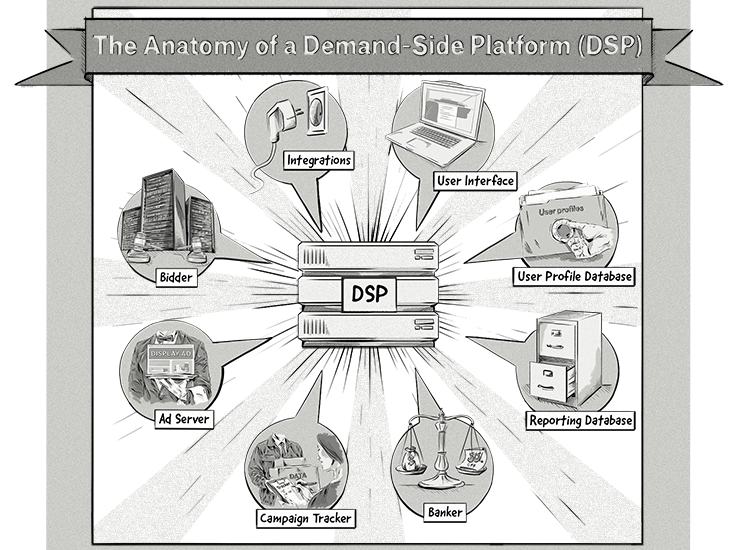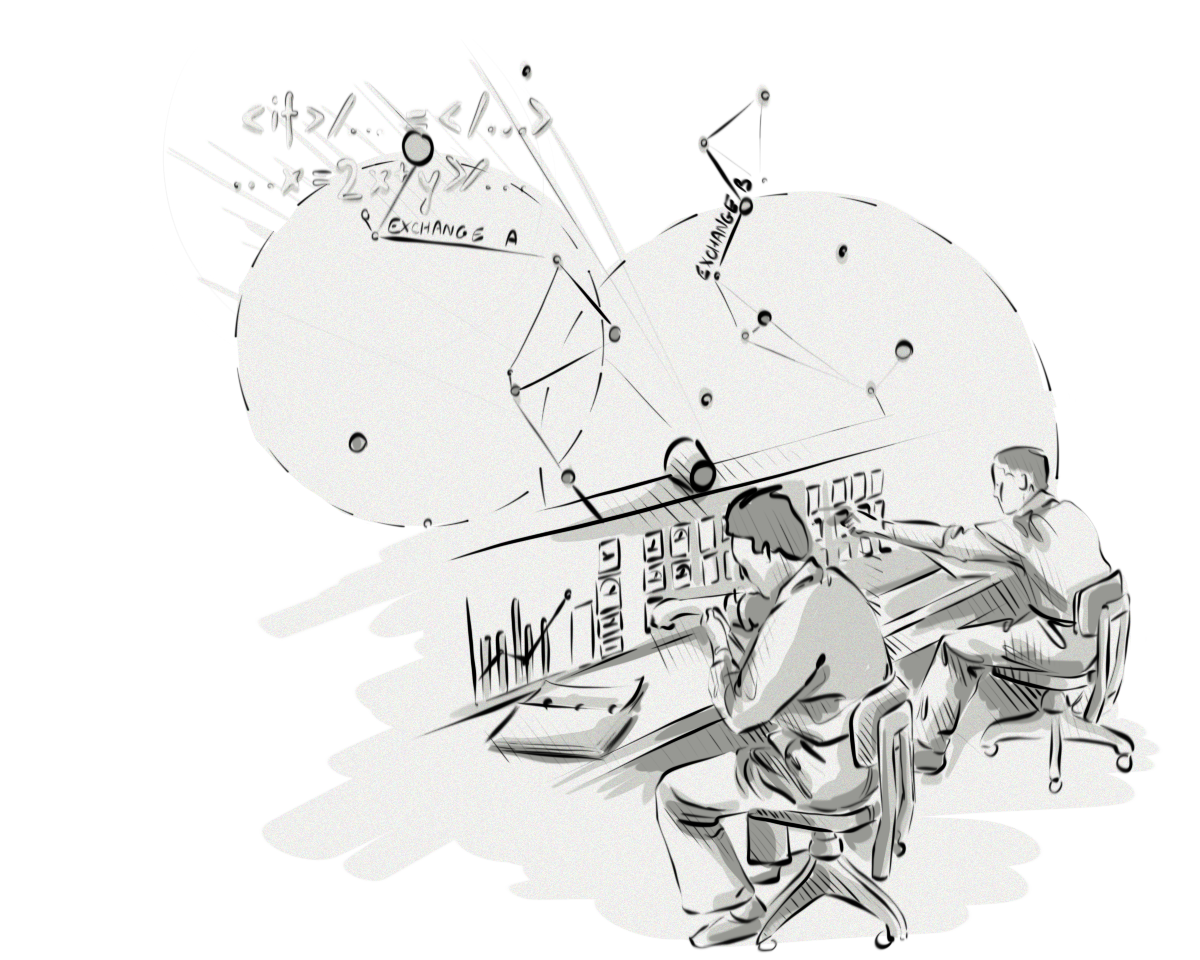A demand-side platform (DSP) is a piece of software that advertisers and ad agencies use when they want to buy ad inventory in an optimally streamlined manner across multiple ad exchanges and supply sources. By leveraging algorithms and real-time bidding capabilities, DSPs give advertisers control and precision in reaching their target audiences.
While there are hundreds, if not thousands, of ready-to-use DSPs on the market, it sometimes makes more business sense for a company to build their own custom DSP.
Although the advantages can be substantial, building a DSP demands significant time and financial investments that not every company may fully benefit from this undertaking. However, for certain businesses, developing their own proprietary DSP might be the only viable option to meet their specific needs.
Read this blog post to learn about the process of building a DSP.
What Is a Demand-Side Platform (DSP)?
A demand-side platform (DSP) is an advertising technology (AdTech) platform that enables advertisers and agencies to purchase ad space on an impression-by-impression basis from publishers via ad exchanges and supply-side platforms (SSPs). The inventory can be purchased in real time through a single-user interface.
With a DSP, advertisers can buy:
- Display ads: These are banners and interactive ads that appear on websites and apps.
- Video ads: These include pre-roll, mid-roll, and post-roll video ads that play before, during, or after online video content.
- Native ads: These are ads that blend seamlessly with the form and function of the platform or website they appear on.
- Mobile ads: These are ads displayed on mobile devices.
- Audio ads: These are ads on audio streaming platforms, podcasts, and internet radio.
- Digital out-of-home (DOOH) ads: These are ads on digital billboards, which are screens in public spaces, transportation hubs, and shopping centers.
- Connected TV (CTV) ads: These are ads delivered through internet-connected smart TVs and streaming devices.
- In-game ads: These are ads placed within video games.
The primary function of a DSP is to purchase ad inventory. However, within the DSP, AdOps can create, run, and manage many ad campaigns simultaneously across multiple SSPs and ad exchanges, increase the ROI of their campaigns via optimization mechanisms, improve targeting by integrating the platform with other data platforms, and analyze the performance of their campaigns with reporting and analytics modules.
We Can Help You Build a Demand-Side Platform (DSP)
Our AdTech development teams can work with you to design, build, and maintain a custom-built demand-side platform (DSP) for any programmatic advertising channel.
How Does a DSP Work?
Advertisers and ad agencies can create, launch, and manage multiple ad campaigns across a variety of supply sources through a single user interface. Most companies have a dedicated team, known as ad operations (AdOps), that is responsible for setting up and managing the ad campaigns inside a DSP.
The mechanisms and components involved in buying ad impressions encompass real-time bidding (RTB) processes and integrations with SSPs and ad exchanges, as well as the use of bidders and algorithms to process data.
The following video explains the simplified process of creating an ad campaign and buying ad impressions using a DSP, ad exchanges, and an SSP:
Here’s a breakdown of the process in detail:
- An advertiser establishes campaigns, including targeting criteria, and creatives (ads), within the DSP.
- Ad exchanges and SSPs notify the DSP about available impressions.
- The DSP analyzes data associated with the impression.
- Based on the relevance to the buyer’s target audience, the DSP determines the value of the particular user who will see the ad.
- The DSP places a bid on the impression, reflecting the maximum amount the advertiser is willing to pay to display their ad to this user.
- The ad exchange or SSP collects bids from multiple DSPs and selects the highest bidder.
- If the DSP wins the bid, the ad is served to the user’s device in real time.
- The DSP continuously monitors and optimizes campaign performance, adjusting bids to maximize ad effectiveness and return on investment (ROI).
- This process is repeated for each impression, allowing the DSP to reach and engage the desired audience efficiently.
The whole real-time bidding (RTB) process happens as the page is loading; it is completed in roughly 100 milliseconds.
Who Can Benefit From Building a DSP and How
While any company can build a DSP, the companies that have the most to gain are advertisers, ad agencies, and AdTech companies. Developing such a platform presents significant business opportunities, including revenue growth, increased market presence, and — additionally, for the AdTech companies — the ability to offer comprehensive solutions to advertisers.
Moreover, a custom DSP can:
- Help companies reduce the commissions they pay to intermediaries.
- Give companies full control over the product roadmap and ownership of the tech — i.e., codebase and intellectual property (IP).
- Provide companies with more control over their data and the media-buying process.
AdTech Companies
Building a DSP allows AdTech companies to tap into the growing programmatic advertising market. By offering a DSP, they can provide advertisers with a comprehensive platform to manage their ad campaigns, opening up new revenue streams through fees, commissions, and licensing models.
A custom DSP also gives AdTech companies full control over the technology and features offered to advertisers. They can tailor the platform to meet specific market demands, including unique targeting options, advanced optimization algorithms, and customized reporting and analytics capabilities.
Another advantage for independent AdTech companies that want to build their own DSP is the ability to develop strategic partnerships with specific SSPs, ad exchanges, DMPs, and verification partners. This allows them to expand their network, create a unique offer, and reach a broader customer base.
Advertisers and Ad Agencies
The main benefits for advertisers and ad agencies include enhanced control over their advertising campaigns, precise audience targeting, efficient and transparent costs, and increased competitive advantage.
In their case, the platform can be aligned with their unique objectives, preferences, and target audience. This level of control enables advertisers and ad agencies to make real-time adjustments, experiment with different strategies, and incorporate algorithms to optimize their campaigns for maximum effectiveness.
They can also use granular targeting options to reach the right audience at the right time, delivering personalized messages that resonate with their customers.
Regarding cost efficiency and transparency, developing a custom DSP eliminates the reliance on third-party platforms, reducing costs associated with platform fees and intermediaries.
And, finally, building a custom DSP positions advertisers and ad agencies as innovators and industry leaders. They differentiate themselves from competitors by offering unique targeting capabilities, customized features, and seamless integration with their existing technology stack.
Key Features of a Demand-Side Platform (DSP)
When developing a DSP, it’s essential to focus on the most important features of the platform, such as budgeting (aka, an ad banker), bidder, integrations, the user interface, the user profile database, the reporting module, the campaign tracker, and the ad server.

Optimization Features
Well-designed DSPs have modules to maintain ad campaigns, optimize ad targeting, and control spending. These are driven by algorithms and machine learning that analyze performance data, adjust bidding strategies, and allocate the budget toward the most effective placements and audiences, thus automatically optimizing campaigns.
- The campaign tracker is the component responsible for collecting data on campaign performance.
- Targeting options allow advertisers and ad agencies to reach their desired audience precisely based on demographics, location, behavior, interests, and device types.
- The ad banker is the module that prevents overspending. It helps manage and control an advertiser’s media spending during real-time bidding.
Integrations
To work correctly — i.e., access a wide range of ad inventory and data sources — a DSP has to be integrated with SSPs, ad exchanges, and DMPs. These integrations allow advertisers to tap into diverse inventory options, reach various publishers, and leverage insights about their desired audience for precise targeting and retargeting.
Analytics and Reporting
DSPs provide comprehensive analytics and reporting capabilities to monitor campaign performance. This can include reporting in real time and customizable dashboards that visualize all necessary or valuable data.
Main Challenges When Building a DSP
Building a DSP is a complex task that involves many different moving parts, each with their own challenges, such as managing technological complexity, integrating multiple features, and maintaining high-speed performance. Here, we address the most common challenges that we at Clearcode have overcome when building DSPs for our clients.
Maintaining High-Speed Performance and Dependability
The DSP must be reliable and perform well under heavy loads, especially during peak traffic times. Ensuring high performance and uptime requires robust architecture and efficient code, which can be challenging to design and implement.
Using microservices, where each part of the DSP works independently from the others, or cloud-based architectures, which can easily scale up or down as needed, can often be the most suitable solution to these challenges.
Achieving Scalability
As the user base and data volume grow, the DSP should be able to scale accordingly to handle increased traffic and data processing. Designing a platform with scalability in mind will help ensure the DSP can handle an increase in usage.
Integrating with Other Platforms
To work properly, DSPs must integrate with various ad exchanges, supply-side platforms, and data management platforms. These integrations must be implemented correctly and tested thoroughly to ensure the DSP can respond to the bid requests within the required timeframe.
Optimal Ad Targeting
Implementing sophisticated algorithms for efficient ad targeting and delivering the right ads to the right users at the right time is a challenge. The platform must analyze user data, context, and behavior to make accurate predictions and decisions.
To process vast amounts of data in real time and predict user behavior, personalize ads, and optimize bidding strategies, a range of technologies can be utilized, including, for example, big data technologies, real-time processing systems, machine learning algorithms, AI, cloud technologies, databases, security technologies, and web technologies.
How Can You Design and Build a DSP?
Developing a demand-side platform is a complex process that involves several steps. Below are the phases that we follow at Clearcode to build DSPs, as well as other programmatic advertising software.
Discovery
First, we:
- Gain an understanding of what you want to achieve with your DSP and get a clear project vision.
- Outline what you’ll need to get your DSP off the ground and identify any potential technical roadblocks related to real-time bidding, ad targeting, and processing large amounts of data.
- Address possible technical limitations, like making sure your DSP can grow with your business, comply with data privacy laws, and make ad targeting as effective as possible.
Sprint 0
Next, we:
- Pinpoint any unknowns in the DSP project and brainstorm ways to solve them.
- Choose the key features for the initial version of your DSP (the minimum viable product or MVP) and put together a to-do list (also known as a backlog) of user stories that define these features.
- Find the best tech tools and design the best setup for efficiently buying ads, managing real-time bidding, and sorting your audience into groups.
- Get started on the groundwork for your MVP or validate a specific part of the project with a proof of concept (PoC).
MVP Development
This is when we:
- Start bringing your DSP to life, including setting up the front-end and back-end development, getting the infrastructure in place, designing the user interface, and making sure everything works as it should with thorough testing.
- Launch your MVP to a small group of users or stakeholders, usually made up of advertisers and marketing folks.
- Get their feedback to help shape the next stage of development, focusing on things like user experience, how efficiently ads can be bought, and what kind of reporting features are needed.
- Keep an eye on how the platform is performing, making sure everything runs smoothly and dealing with any unexpected problems that crop up.
Post-MVP Development and Maintenance
After the MVP, we:
- Keep working on your DSP in short, focused bursts (known as 2-week sprints) with the aim of adding new or better features each time, like more advanced targeting options or more detailed analytics.
- Offer ongoing help and maintenance to make sure that the software and infrastructure stays up and running and that any problems are sorted out quickly.
- If needed, we’ll hand the project over to your team, giving them the documentation and access they need to manage and maintain the DSP.
Examples of Clearcode-Built DSPs
Kanary NEST
Our client, Kanary NEST, partnered with us to build a scalable demand-side platform designed for programmatic media buying in the online display advertising industry.
The main challenges included developing a platform that could handle billions of bid requests and display the data in real time.
To deliver the platform, we blended several technical solutions and coupled them with a user-friendly interface and sharp design elements.
- We architected the system design with horizontal scalability in mind, empowering the platform to manage billions of bid requests daily, despite being built on a limited infrastructure.
- To deliver an ultra-fast platform, we used multiple software development solutions and tools, including Python, Twisted, Redis, Storm, and others.
- To provide marketers with access to the major biddable display advertising inventories, we integrated Kanary with AppNexus and ad exchanges supporting OpenRTB protocols, such as Nexage.
Starting from scratch, we constructed the project and introduced the minimum viable product (MVP) to a select group of beta testers. Their initial feedback guided our enhancements and the platform’s ongoing development. It was showcased at the TechCrunch Disrupt 2013 conference in New York, where it gained significant praise. Later, in August 2014, Kanary NEST was acquired by Gravity4 — an AdTech company based in Silicon Valley.
SITO Mobile
SITO Mobile, a mobile DSP that leverages location-based technology, engaged us to optimize their infrastructure, access a broader amount of inventory, and minimize discrepancies between their SSP partners.
The primary challenges involved gaining access to more extensive inventory and optimizing the infrastructure to increase the number daily impressions the DSP could process.
Key points:
- We integrated the SITO Mobile DSP with various ad exchanges and SSPs, enhancing its capacity to handle bid requests per second, automating routine tasks, and improving report generation based on tracked events.
- We designed solutions to handle the discrepancies between the DSP and ad exchanges/SSPs by working directly with them to develop custom reporting mechanisms. This action drastically reduced the discrepancies from around 50% to 1%, thereby improving SITO Mobile’s media spend and positively affecting their bottom line.
- For improved platform stability and constant monitoring, we offered SITO Mobile a service-level agreement (SLA) that provided 24/7 monitoring. This resulted in immediate responses to performance issues, proactive avoidance of potential problems, and frequent infrastructure optimizations.
Our partnership with SITO Mobile profited from our vast experience in advertising-technology development, which enabled us to understand the specific needs of the project, engage proactively with other vendors, and recommend solutions based on our knowledge of the online advertising ecosystem.
Ad Banker Case Study
Clearcode developed a distributed budget management tool, referred to as “the ad banker”, specifically for real-time bidding. This tool aids tech firms in avoiding budget overspend and shortening the development timeline when constructing a demand-side platform (DSP). Our benchmark tests found that the ad banker can reduce budget overspending from 37.2% to just 1.2%.
We Can Help You Build a Demand-Side Platform (DSP)
Our AdTech development teams can work with you to design, build, and maintain a custom-built demand-side platform (DSP) for any programmatic advertising channel.








